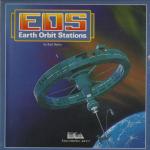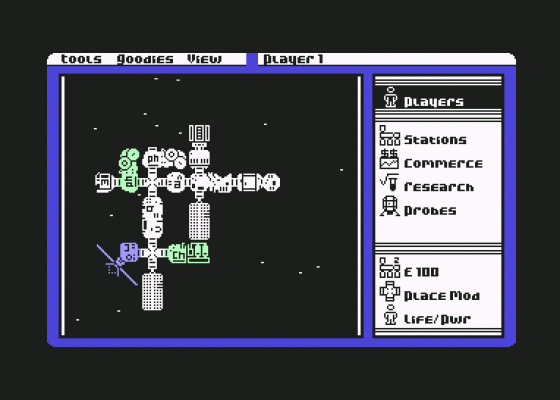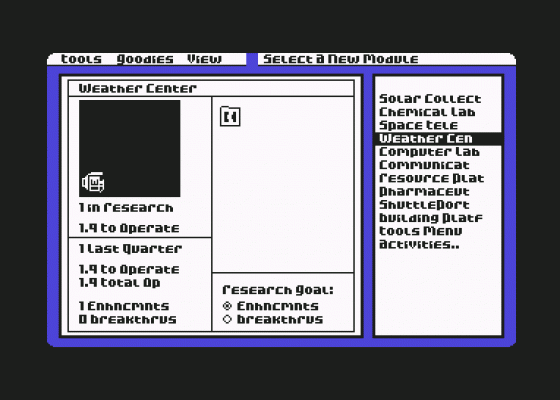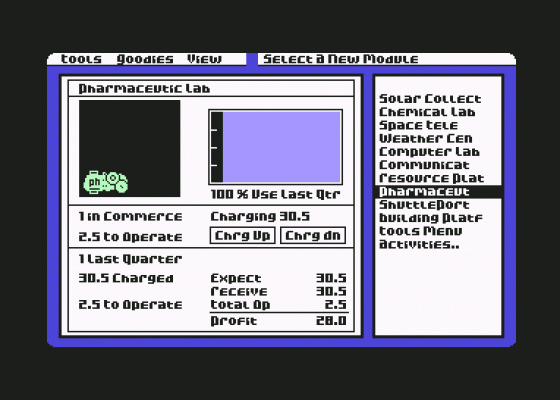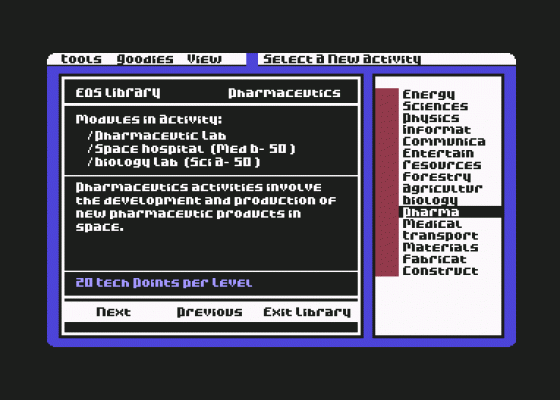
Commodore User
 1st October 1987
1st October 1987
Categories: Review: Software
Author: Bohdan Buciak
Publisher: Electronic Arts
Machine: Commodore 64/128
Published in Commodore User #49
EOS
Now that the American space programme has ground to a halt, NASA boffins might try whiling away the years before the next blast-off by playing EOS. EOS stands for Earth Orbit Stations and it's a very big game indeed. If you've got plenty of time on your hands (like early retirement) and you enjoy wheeling and dealing, this is the game for you.
Just to prove how big it is, there are seven different games scenarios which interlink and gradually become more complex. The blurb tells us each game can take between two and 40 hours to complete. Take it steadily (why rush?) and you could be playing for up to 300 hours. Up to four players can take part. This could be difficult - try placing an ad with your local job centre. If there are no takers, the computer will play instead.
The instruction book is 14 pages of total incomprehensibility, there are three disks and a mission disk which you must format and copy before starting every new game. So merely setting things up takes about twenty minutes. But what's twenty minutes when a whole lifetime of EOS looms?
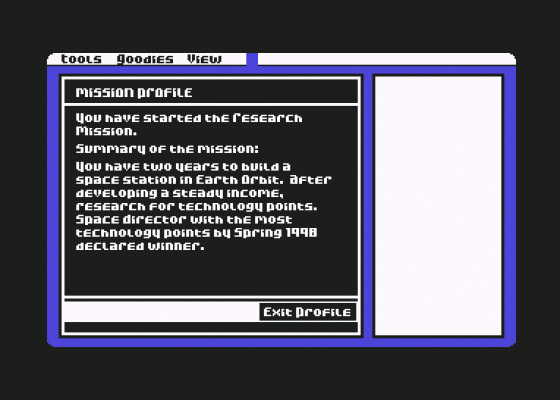
EOS is a space strategy game that involves you building space stations for commercial gain. As the blurb drawls, "Profits are the mother's milk of the space industry". Having built your stations, you attach a variety of modules to them. These modules perform functions for which you can charge users. So you make lots of money and gain a higher Tech Level in order to build more specialised and advanced stations that lead to more difficult and lucrative game scenarios.
Space stations are built rather like putting together pieces of a jigsaw. Each module has one or more connecting points and you place them together on a large grid. This is not just a little interlude. Arrange your modules carelessly and you run out of connecting points and you'll waste money buying connections. Once placed, a module cannot be moved.
There are two types of module: research/commerce and support. Before any research/commerce modules can be attached to the station, the required number of support modules must be in place. You require command and logistics modules, sufficient power, life and GGym (food and exercise) for the research/commerce modules to become active. Error messages will appear if you try doing something that won't work.

There's a range of sixteen commercial functions, each with its own modules. They're all listed in terms of functions and activities, cost of operation and their operating requirements. Some modules don't become available until you've reached a higher tech level
Apart from physical requirements, deciding which research/commerce modules to attach to your station involves analysing the 'market' for information on which activities are and aren't in demand. Modules are set to either commerce or research. Research involves greater financial gain but more risks.
Market information is always available, as are statistics on the performance of each of the functions, your own financial position and those of any other players. This is no doddle, it makes the FT read like the Beano.

As you'd expect, there's a bank involved. You can go to the bank for a loan, deposit any income you've made and pay off loans in order to start building more stations. When you get more used to playing (say, next year) there's potential to advertise your services, get a sponsor and wheel and deal with the other players.
EOS works by allowing each player one 'turn' of making money for each quarter-year of the game. The first game, Research, lasts two years so you each get eight turns. The instruction book gives a step-by-step guide to what a 'turn' consists of. Figures for each player can be gained after each quarter and at the end of the game. The player with the most money at the end wins.
If you're playing the computer, you get a fleeting glimpse of the type of station it's built. If you're quicj enough, you can note down the modules used and try making a better job of your own next time. I invariably finished up owing lots of money to the bank and not making enough on my stations. Meanwhile, the computer was raking it in.
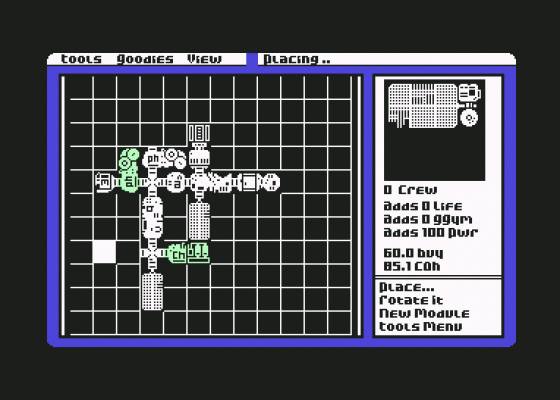
Now for the advanced stuff. If you've made enough money on the first game, you then start building for the future. The next scenario, Dry Dock, involves you building one of the aforementioned. This stands you in good stead for later games that involve building Cargoliners and Jupiter Explorers. Jupiter Explorers and probes are sent out to look at other planets in the Solar System.
More advanced scenarios include rescuing a space settlement on Mars, building a settlement on the moon and building a space colony to orbit the earth. This culminates in the final game, Search for Life, in which you have no less than ten years to probe for life in the Solar System and report discoveries.
By the way, the blurb tells us EOS is a simulation based on NASA's plans for the next fifty years. So now you know, these guys really are fruitcakes.
I don't know what to make of EOS. The game is difficult to grasp, but then again it should be if it hopes to sustain so many hours of play. There is a confusingly large range of menus, each holding reams of information. Again, this is necessary to give the game sufficient depth for sustained play. So there's lots of reading involved and legibility isn't helped by stupidly customised 'space type'.
EOS is impressive in its size and complexity but it will appeal only to those of you who like getting totally immersed in an idea and sticking with it for a long time. If you fit the bill, grab this game. If you're a joystick pusher who likes action and variety, stay well clear.
Other Reviews Of Earth Orbit Stations For The Commodore 64/128
Other Commodore 64/128 Game Reviews By Bohdan Buciak
Scores
Commodore 64/128 Version| Graphics | 70% |
| Sound | 20% |
| Toughness | 80% |
| Endurance | 80% |
| Overall | 60% |

